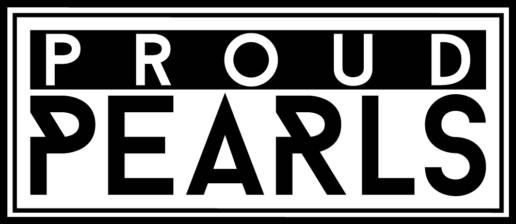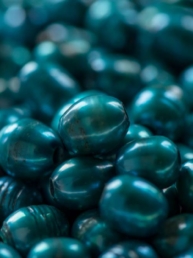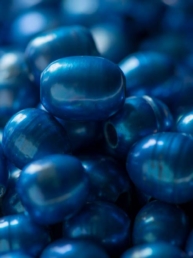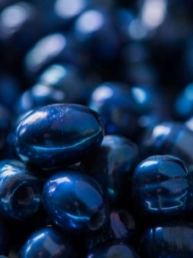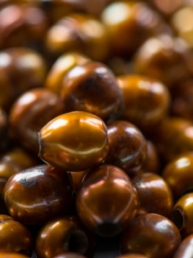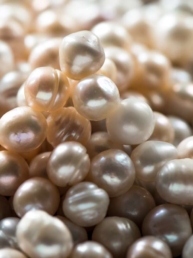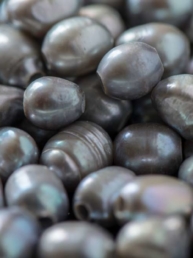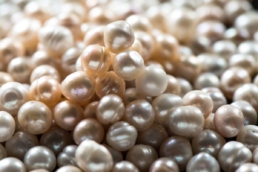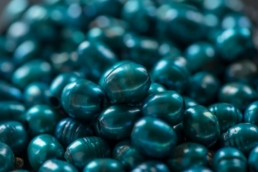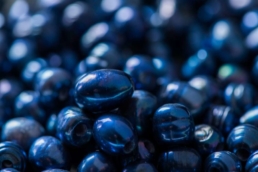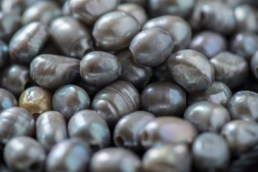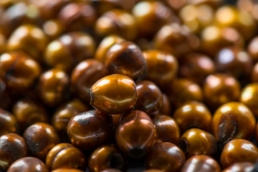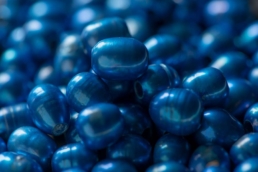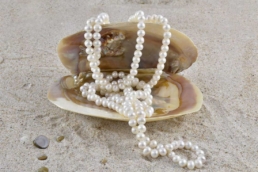How to recognise real pearls
Proud Pearls guarantees that all of the pearls used in our pieces are real, but how can you tell whether they are real or fake on your own…
Some simple tests can help you determine whether your pearls are real or not. If you have any doubts about the authenticity of the pearls you have in your possession, you can always have them tested by us.
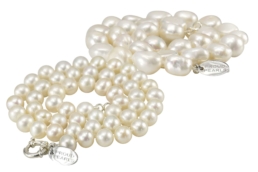
On the is left an example of the highest quality AAA pearls, these are round pearls. On the right is an example of Baroque pearls, also commonly referred to as “wild” pearls. Read more about the different types of pearls in our other blog posts.
1: Look for minor imperfections:
Real pearls are rarely “perfect”. Real pearls usually have minor imperfections or irregularities in their shape. The outer layer of mother-of-pearl can reflect the light differently on different parts of the pearl. Imitation pearls are almost always too perfect, they appear perfectly round, they have an even shine throughout, and have no dents or other flaws. Even though there are perfectly round pearls, they are very rare and a necklace seldom consists entirely of this type of pearls. A necklace made of pearls that all appear to have the same smooth, round shape is almost certainly a fake.
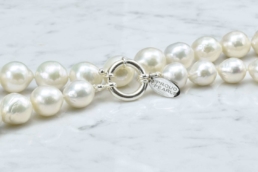
2: Examine whether the pearls have a sharp, healthy shine:
“Lustre” or shine is a term used by jewellers to describe the type of light being reflected from a pearl. The shine is one of the things that makes a pearl so beautiful; good quality pearls have a bright and clear lustre that makes them sparkle when light shines on them.
Pearls come in all shapes and colours: freshwater pearls can be white or pastels such as lilac, cream, or pink. Pearls can also be dyed to other colours, you can read more about this process in our other blog posts about the different types of pearls.
3: Look at the overtone:
High-quality pearls are often valued for their overtone, which is the subtle colour that shows on the surface when light hits them. Imitation pearls tend to not have this effect because this overtone is hard to emulate. As such, if you notice that your pearls have a bit of a different colour when light falls on them, chances are that your pearl is real. Pink and ivory are two of the most sought after overtones for white pearls, but many different colours are possible.
4: Look for clues near the borehole:
Pearls that are part of a strand or necklace usually have drill holes for the cord to pass through. Studying these holes carefully can help you find out if the pearl is real or not. Pay attention to the following things:
A drill hole with clear edges. Real pearls usually have sharp-edged boreholes (like a hollow cylinder). Imitation pearls often have rough or rounded edges. However, older, more worn real pearls can also have boreholes with rounded edges. Drill holes in imitation pearls can also bend outward on the surface of the pearl, instead of being perfectly cylindrical.
Chipped paint or varnish around the hole. Imitation pearls rub against each other when you wear them often and the imitation varnish around the holes can therefore wear away. You may see splinters of glass or plastic under the paint. This is a clear sign that the pearl is not real.
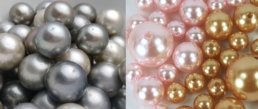
The pearls to the left are a good example of precious Akoya (sea pearls), the pearls on the right are a good example of “perfect” fake pearls.
5: Look in the Drill hole to see if you can see a line between the mother-of-pearl and the core:
Pay attention to the following: a real pearl almost always has a clear outer layer of mother-of-pearl, while imitation pearls have thin layers of imitation mother-of-pearl or none at all. If your pearl has a borehole, you can use a magnifying glass to see if it has a layer of mother-of-pearl. Real pearls usually (but not always) have a clearly visible stripe that separates the mother-of-pearl from the core (the inner part of the pearl).
6: Rub the pearls against your front teeth:
Hold one or two pearls between your thumb and forefinger and gently push them against the cutting edge of your front teeth. Rub them along your teeth in a sideways motion. A real pearl usually has a slightly rough or grainy texture caused by tiny, flaky blemishes in the outer layers of the pearl. Imitation pearls of glass or plastic are usually almost perfectly smooth.
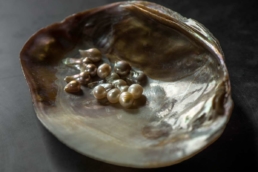
Sea pearls grow in oysters, freshwater pearls grow in large mussels, above is an example of freshwater pearls, read more in our blog about pearl cultivation.
7: Rub the pearls together:
Hold a few pearls between your fingers and gently rub them together. See if you feel a slight friction. Rubbing real pearls together will usually create some friction because the outer layers of the mother-of-pearl are not perfectly smooth. Imitation pearls, on the other hand, often have a smooth finish and will therefore slide past each other when you rub them together.
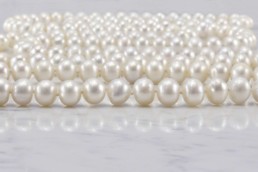
In the photo an example of the beautiful round AAA quality pearls that we use in our collections.
8: Check if the pearls are not “too perfectly” round:
Since pearls are natural products, every real pearl is slightly different, just like snowflakes or fingerprints. Most pearls will not be perfectly round, they are usually a bit oval or have minor flaws. If your pearls look perfectly round, chances are they are imitation pearls. However, real pearls can be perfectly round, these pearls are very rare and therefore very expensive. Perfectly round pearls are referred to as AAA pearls, we also use them in our collections, but these pieces are a lot more expensive than jewellery with baroque pearls.
9: See if the pearls feel cool:
For this test, you will need some pearls that you have left somewhere for a long time – not pearls that you have worn. Hold the pearls in your hand and pay close attention to how they feel. Real pearls will feel remarkably cool for a few seconds before heating up. It feels similar to stepping on a marble floor with bare feet. Plastic pearls, on the other hand, will be about room temperature and will also heat up faster. Please note, good quality glass imitation pearls can still feel “cool”. If this is the first test you’ve tried, run more tests to see if your results are correct.
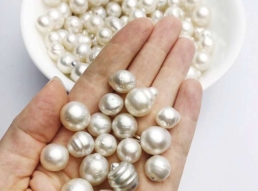
10: See how heavy the pearl feels in your hand:
Gently bounce one or two pearls into your hand to get an idea of how heavy they are. Most real pearls feel a little too heavy for their size. However, imitation pearls (especially plastic ones) will feel light and hollow. Obviously, this test is not perfect, it can be difficult to determine the weight of a few small pearls. For the best result, it is best to compare your pearls with pearls that you are sure are real or fake. Always check the results by running another test, no matter how confident you are of the weight of a pearl.

Fake pearls production: glass beads are dipped in a “mother-of-pearl” solution.
Majorica pearls and other fake pearls
Running in a completely different direction, Majorica pearls, sold in red boxes, are artificially made pearls in a factory. These pearls are made of glass balls that are immersed in a solution made of, among other things, fish scales. The layer on the glass is usually thin and can wear off over time. On the island of Mallorca, many of these pearls are falsely sold as real pearls. These tend to be targeted towards tourists. In addition to factory pearls made from fish scales, there are also shell pearls, which are made by sawing blocks from thick shells and grinding and polishing them. You can recognise a cord with shell pearls because all pearls have the same shape and are perfectly round. There are also plastic pearls and glass pearls on the market, of course, these have nothing to do with natural or cultured pearls.
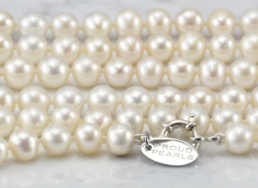
We give a 100% guarantee that all of the pearls in our collections are real, if you have any doubts about the authenticity of other pearls that you have in your possession, you can always have them tested by us.
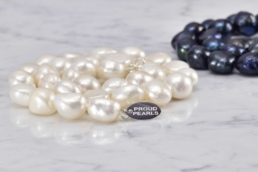


Bron: https://nl.wikipedia.org
